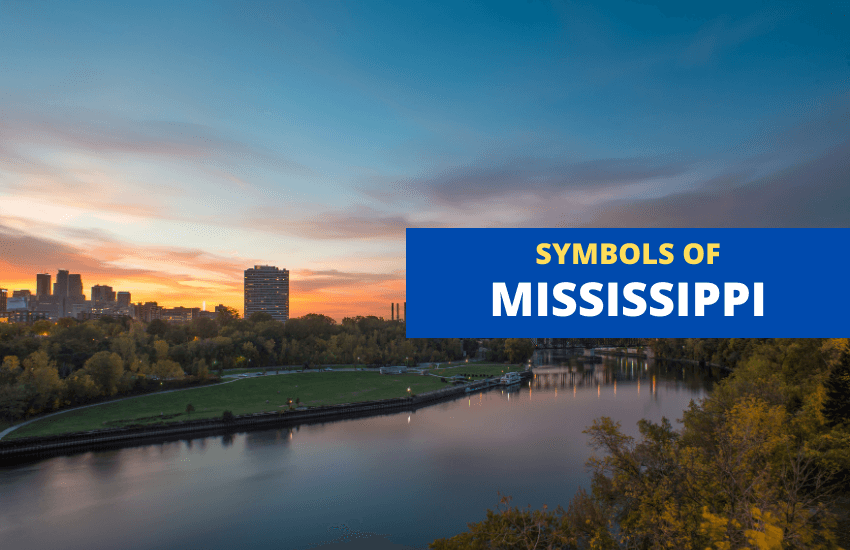
Table of Contents
Mississippi, located in the Deep Southern region of the U.S., is one of the largest and most populated U.S. states. The birthplace of Elvis Presley and the Blues, Mississippi has had a great impact on the music world and many notable authors like William Faulkner and Tennessee Williams were also born in Mississippi.
After the French and Indian War, the region of Mississippi came into British hands but after the Revolutionary War, it passed back into the hands of the U.S. It became a U.S. territory in 1798 and played an important role in the Civil War since its location made it strategically important to both the Confederacy and the Union. In 1817, it was made the 20th state of the U.S and the original capital city, Natchez was moved a number of times until Jackson was finally chosen as the capital.
Mississippi has several official and unofficial symbols that represent its historical and cultural heritage. Here’s a look at some of the most significant symbols of Mississippi and what they represent.
The Flag of Mississippi

The state of Mississippi currently hasn’t got an official state flag since the most recent version retired in June, 2020. The retired flag was designed by Edward Scudder and adopted in 1894. It was a tricolor flag with three equal-sized, horizontal bands of white, blue and red and the Confederate battle flag was depicted in its canton (rectangular area within a flag). The thirteen stars represented the number of original states in the Union.
Since the state is currently without an official flag, Mississippi uses the flag of the United States for all official purposes and the other symbols used to represent the state are a seal and the coat of arms.
Seal of Mississippi
The Great Seal of the state of Mississippi was adopted in 1798, when Mississippi was still U.S. territory. It displays an eagle with its head held high, wings spread wide and a shield with stripes and stars centered on the eagle’s chest. In its talons, the eagle clasps arrows (symbols of strength and power to wage war) and an olive branch (a symbol of peace). The seal’s outer circle contains the words ‘The Great Seal of the State of Mississippi’ on the top part of it and at the bottom the words ‘In God We Trust’.
The Mockingbird
In 1944, the Women’s Federated Clubs of the state of Mississippi held a campaign to select the official bird of their state. As a result, the mockingbird was chosen and was made the official bird of Mississippi by the state legislature.
The mocking bird is a small, passerine bird with extraordinary vocal ability and can mimic up to 200 songs and sounds of other birds, amphibians and insects. Its appearance is quite plain, clad in gray shades with white, conspicuous wing patches but it’s an exceptionally popular little bird. Symbolizing innocence and beauty, the mockingbird is so popular that it was made the official state bird of several states in the U.S. other than Mississippi.
Bottlenose Dolphin
The bottlenose dolphin is an extremely intelligent mammal, that’s found wherever there’s temperate and warm seas. These dolphins grow up to 4 meters in length and weigh an average of 300kg. Their colors vary considerably, but they’re usually a dark gray, bluish-gray, light gray, brownish-gray or even black. Some bottlenose dolphins also have a few spots on their body.
Bottlenose dolphins are capable of mimicking certain sounds highly accurately and are good at learning other dolphins’ whistling sounds, something which serves as a way of individual identification like having a name. In 1974, it was made the official water mammal of the state of Mississpi and remains a symbol of innocence and good fortune.
Magnolia
The state flower of Mississippi is the magnolia (designated in 1952), a large flowering plant species that was named after Pierre Magnol, the French botanist. It’s an ancient genus of flowering plant, appearing long before bees did. It’s characterized by its large, fragrant flowers that are either star-shaped or bowl-shaped and found in several colors including pink, white, green, yellow or purple. Magnolias are commonly found in North, Central and South America as well as in several southeast Asian and east Asian countries.
Because the magnolia has been around for millennia, it’s symbolic of perseverance and longevity. Magnolias also represent nobility, feminine sweetness, beauty and a love for nature.
The Teddy Bear
The teddy bear is the official toy of the state of Mississippi, designated in 2002. It’s said that the teddy bear was named after U.S. President Theodore Roosevelt when a toy store owner in New York saw a political cartoon about the president refusing to shoot an injured bear. The store owner asked the president’s permission to name his small sized, stuffed bear cub toys ‘Teddy’s bears’ to which the president consented. The name caught on and later ‘Teddy’s bears’ became Teddy Bears’. Today, all stuffed bear toys in the world are called teddy bears or even just ‘teddies’.
Square Dance
The Square Dance is the official American folk dance adopted in 1995. It’s the state dance of 22 U.S. states including Mississippi. Square dance is a dance form that’s uniquely American although many of the dance moves and its terminology was brought to the United States from other countries by early emigrants. Some moves are borrowed from dances like Irish jigs, Spanish fandangos, English reels and French quadrilles and these have blended with the American customs and folkways into the square dance. Performed by four couples (8 people in total) who stand in a square with each couple facing the other, square dancing is an excellent way for dancers to socialize with one another while having fun.
American Alligator
The American alligator, the official state reptile of Mississippi is a large reptile native to south-eastern United States and lives in freshwater wetlands like swamps and marshes. It plays an important role in the ecosystems of wetlands by creating alligator holes which provide wet and dry habitats for other creatures and its nesting activities results in the creation of peat, a brown deposit that’s similar to soil and used in gardening.
A strong and powerful reptile, American alligators have virtually no natural predators, but they have been hunted in the past by humans. As a result, they were headed towards extinction. Thanks to the measures taken to conserve and protect this reptile, its status has now changed from endangered to just threatened.
The American Oyster Shell
The American oyster, native to North America, has been highly popular commercially and is extremely valuable to the environment as a filter feeder. This means that it sucks water in and filters out plankton and detritus which it swallows, then spits the water back out. As a result, it cleans the water around it. A single oyster has the ability to filter over 50 gallons of water in only 24 hours. A valuable resource of the Gulf Coast of Mississippi, the American oyster shell was designated the official shell of the state in 1974.
The State Capitol
The State Capitol of Mississippi, also known as the ‘New Capitol’, has been the government seat of the state since 1903. Located in Jackson, the capital city of Mississippi and the most populous city of the state, the capitol building was officially designated a Mississippi Landmark back in 1986. It’s also on the National Register of Historic Places.
The capitol was built on the old State Penitentiary and exemplifies the Beaux Arts architectural style. Perched on the top of the building’s dome is a gold-coated American Bald Eagle facing south, a national emblem, symbolizing the freedom and strength of America. The capitol is open to the public and visitors can choose to have a guided or self-guided tour.
‘Go Mississippi’
Written and composed by William Houston Davis, the song ‘Go Mississippi’ is the regional anthem of the state of Mississippi, designated in 1962. The state legislature had selected the song from two compositions, the other one being ‘Mississippi, U.S.A’ which was also created by Houston Davis. ‘Go Mississippi’ was received with a lot of enthusiasm by 41,000 fans at the formal dedication by Governor Barnet in September 1962 and was performed by the ‘Ole Miss Marching Band’ during the football game. Since the song was the more popular one of the two options that were available, the state legislature found it easy to decide which one would suit as the state anthem.
Coreopsis
The coreopsis is a flowering plant also commonly known as tickseed and calliopsis. These plants grow up to 12 cm in height and have yellow flowers with a toothed tip. Some are also bicolor, featuring red and yellow hues. Coreopsis plants have little flag fruits that are small, dry and look similar to bugs. In fact, the name ‘Coreopsis’ came from the Greek words ‘koris’ (bedbug) and ‘opsis’ (view), referring to these fruits.
The flowers of the coreopsis are used as pollen and nectar for insects and they’re also known to provide food specifically to certain species of caterpillars. Native to Central, South and North America, the coreopsis symbolizes cheerfulness and it can also symbolize love at first sight. Since 1991, it has been the official state flower of Mississippi.
Check out our related articles on other popular state symbols:








